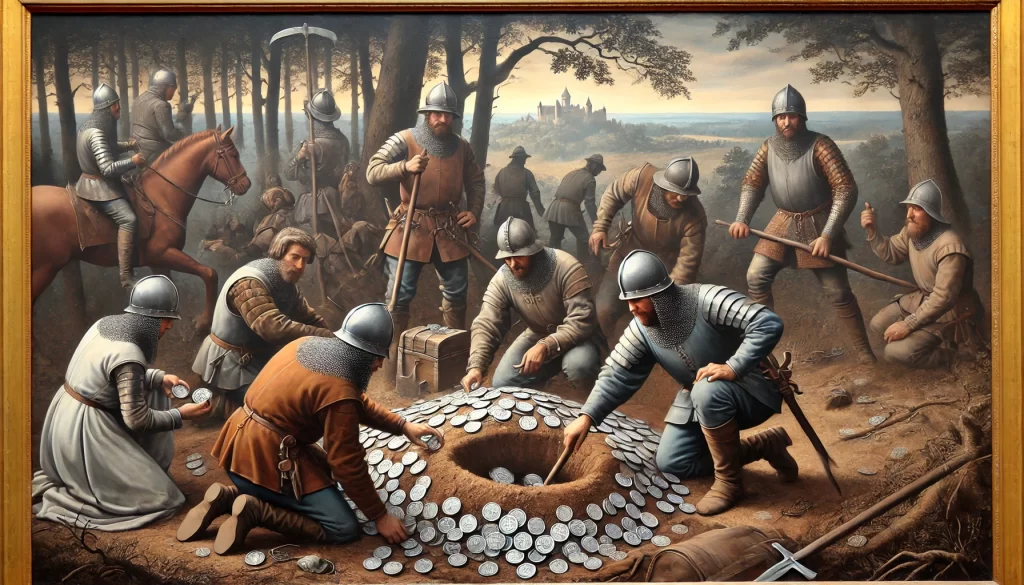Two significant hoards of ancient coins have recently been unearthed by metal detector enthusiasts, offering rare glimpses into the economic and political histories of Viking and Norman eras in the British Isles. These discoveries, one from the Isle of Man and the other from the Chew Valley in England, reveal not only the wealth of these periods but also the historical transitions and trade networks that defined them.
Viking Coins Found on the Isle of Man
A remarkable collection of Viking silver coins, thought to be about 1,000 years old, was discovered earlier this year on the Isle of Man by two metal detectorists, David O’Hare and John Crowe. The discovery was made on private land, and the pair had secured permission from the landowner before conducting their search. The hoard of 36 silver coins has since been declared treasure and is now on display at the Manx Museum.
The coins represent a variety of rulers, including Edward the Confessor, King Canute, and other leaders from the Viking age. Experts believe that the hoard was buried in three stages, with the final addition made in 1070. This suggests that the collection may have functioned as a sort of “savings account,” where coins were added or removed over time, reflecting the island’s role as a trading hub in the Viking age. Alison Fox, a curator at Manx National Heritage, remarked that the discovery offers “a really interesting snapshot of the Viking age,” providing insight into how people on the Isle of Man engaged in trade and accumulated wealth from various parts of the British Isles and beyond.
The coins were minted in a range of locations, including Ireland, York, Lincoln, and Hastings, highlighting the broad geographical range of trade during the Viking period. According to Fox, this find is of particular importance due to its completeness and the fact that the discoverers “resisted the urge to clean the coins,” allowing archaeologists to study the materials that remained on them, such as lead deposits and textiles. These details provide further evidence of how and why the hoard was buried.
This hoard is not the only recent discovery of Viking coins on the Isle of Man. According to Kristin Bornholdt Collins, an expert on Viking Age coins, another hoard discovered earlier this year sheds light on the island’s Viking economy, where silver played a crucial role. “This new hoard might be compared to a wallet containing all kinds of credit cards, notes, and coins, perhaps of different nationalities,” Collins explained. This metaphor underscores the variety of currencies used by traders and inhabitants of the Isle of Man during this period.

Norman Coins Discovered in Chew Valley, England
In a separate discovery, a group of seven friends, including treasure hunters Lisa Grace and Adam Staples, found a massive collection of nearly 2,600 Norman silver coins dating back to the 11th century. The coins, which were found in January 2019 in the Chew Valley, England, are now recognized as the most valuable treasure find ever recorded in the United Kingdom. The hoard has been valued at £4.3 million ($5.6 million), with half of the proceeds going to the group of finders and the other half to the landowner.
The coins date from 1066 to 1068, a period of significant turmoil and transition in English history. This was the time of the Norman Conquest, when William of Normandy, later known as William the Conqueror, defeated Harold II at the Battle of Hastings, marking the end of Saxon rule in England. The hoard contains coins featuring William I, Harold II, and even Edward the Confessor, the last king of the House of Wessex who was later made a saint.
Experts believe that the coins were likely buried around 1067 or 1068 during local rebellions against William’s new rule. The hoard provides important insights into this chaotic period of English history. According to Chris Bryant, the British minister responsible for heritage, the find offers a “unique insight into our country’s rich history and one of the most important moments in our history, when these islands were thrown into turmoil by the Norman Conquest.”
After being purchased by the South West Heritage Trust, the coins are now set to go on display at the British Museum and later tour other museums across the UK before finding a permanent home at the Museum of Somerset. This arrangement will allow people from various regions to view the coins and learn more about the country’s history. The acquisition was made possible through funding from the National Lottery Heritage Fund, the Art Fund, and local organizations like the Friends of the Museum of Somerset.
Impact of the Finds on Historical Understanding
Both the Viking and Norman coin hoards offer invaluable opportunities for historians and archaeologists to better understand the economies, cultures, and political landscapes of their respective periods. The Viking hoard from the Isle of Man underscores the island’s importance as a center of trade in the Irish Sea, where Norsemen, English, and Irish people interacted regularly. The variety of mints and rulers represented in the hoard paints a picture of an interconnected world where currency flowed freely across borders.
Meanwhile, the Norman hoard from Chew Valley provides a tangible link to one of the most transformative moments in English history—the Norman Conquest. The presence of coins from multiple rulers reflects the dramatic shifts in power that took place over just a few years. These finds are not just valuable for their monetary worth but also for the light they shed on the complexities of these historical transitions.
This article is based on the following articles:
https://www.bbc.com/news/articles/cx2537zq50qo
https://www.washingtonpost.com/world/2024/10/22/norman-coins-hoard-sold-uk-most-valuable-treasure

Background Information
Background on the Viking Age
The Viking Age refers to the period from around 800 to 1066 CE when Norsemen, commonly known as Vikings, traveled extensively throughout Europe. The Vikings were not just raiders, as they are often depicted, but also traders, explorers, and settlers. They originated from Scandinavia (modern-day Norway, Denmark, and Sweden) and expanded their influence by traveling across seas and rivers, often settling in areas such as the British Isles, Ireland, and parts of what is now France.
- Isle of Man’s Role in Viking History: The Isle of Man, where one of the coin hoards was discovered, was a key location during the Viking Age. It’s an island in the Irish Sea, located between Great Britain and Ireland. Because of its strategic location, it became a central trading hub for the Vikings. They used the Isle of Man as a base for both trading and raiding. The island has a strong Norse heritage, which is evident in the artifacts and coins discovered there.
- Viking Economy: The Vikings used silver as their primary form of currency. Silver was often melted down and shaped into coins or bars, which were used for trade. The coins found in the Isle of Man reflect the international nature of Viking trade, as they came from different mints across Europe. This shows that the Vikings were part of a larger trading network that connected various regions, including England, Ireland, and Scandinavia.
- Importance of Coin Hoards: During the Viking Age, it was common for people to bury their wealth for safekeeping, especially during times of unrest or when they were traveling. These buried collections, called hoards, often contained silver coins, jewelry, or other valuable items. Many hoards have been discovered by metal detectorists and archaeologists, providing valuable insights into how people lived, traded, and interacted during this time.
Background on the Norman Conquest
The Norman Conquest is one of the most important events in English history, marking the beginning of Norman rule in England. It took place in 1066, when William, Duke of Normandy (a region in modern-day France), invaded England and defeated the English king, Harold II, at the Battle of Hastings.
- Why William Invaded: William believed he had a legitimate claim to the English throne after the death of Edward the Confessor, the last Anglo-Saxon king of England. However, the throne was claimed by Harold II, leading to a conflict. William’s victory at Hastings changed the course of English history.
- Changes in England: After the conquest, William became known as William the Conqueror, and he introduced many changes to England. Norman influence reshaped English society, architecture, and governance. Castles were built to help William control his new kingdom, and many of the English laws and practices were changed to fit Norman customs.
- Norman Coins and their Significance: Coins from this period, such as those found in the Chew Valley, are valuable because they provide insight into the transition from Saxon to Norman rule. Coins from different rulers (Harold II, William I, and Edward the Confessor) reflect the rapid political changes that occurred during and after the conquest.
Importance of Metal Detecting in Archaeology
Metal detecting is a popular hobby, especially in places like the United Kingdom, where there is a rich history of buried treasures. People who use metal detectors to find historical objects are called detectorists. Sometimes, detectorists make important discoveries, like the Viking and Norman coin hoards mentioned in the articles.
- The Treasure Act of 1996: In the UK, there is a law called the Treasure Act of 1996. This law helps ensure that important historical finds, like coin hoards, are properly reported and preserved. If someone finds treasure, they must report it to the authorities. If the find is declared treasure, it can be bought by museums to be preserved for the public. In return, the person who found the treasure and the landowner may receive a share of the value of the find.
- Preserving History: The discoveries of these ancient coins are important because they help archaeologists learn more about the past. Coins are particularly useful because they often bear the names and faces of rulers, as well as symbols that reflect the time period. By studying coins, historians can understand more about trade, economy, and political power during different periods of history.
Key Terms for Understanding the Articles:
- Hoards: Collections of valuable objects or coins, often buried for safekeeping.
- Metal Detectorists: People who use metal detectors to search for hidden or buried metal objects, such as coins or jewelry.
- Vikings: Norse people from Scandinavia known for their seafaring, trading, and raiding activities between the 8th and 11th centuries.
- Norman Conquest: The invasion and conquest of England by William the Conqueror in 1066.
- Mint: A place where coins are produced.
Please subscribe to Insight Fortnight, our biweekly newsletter!
